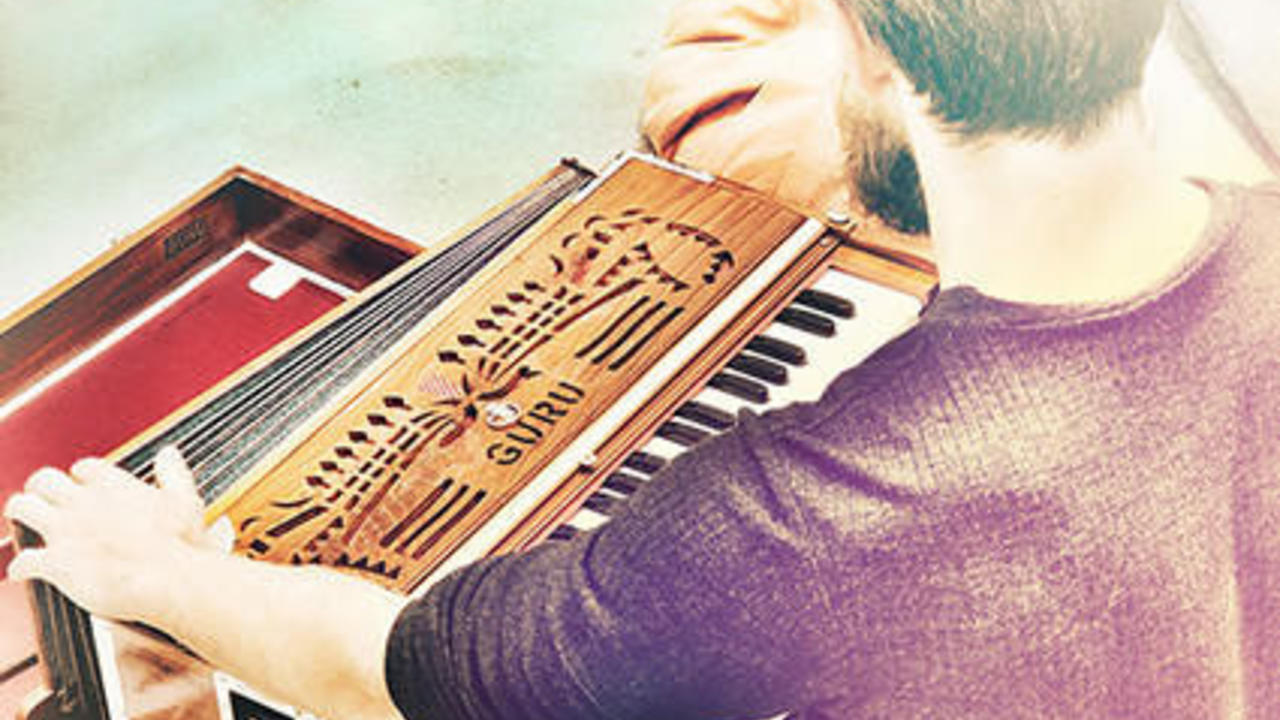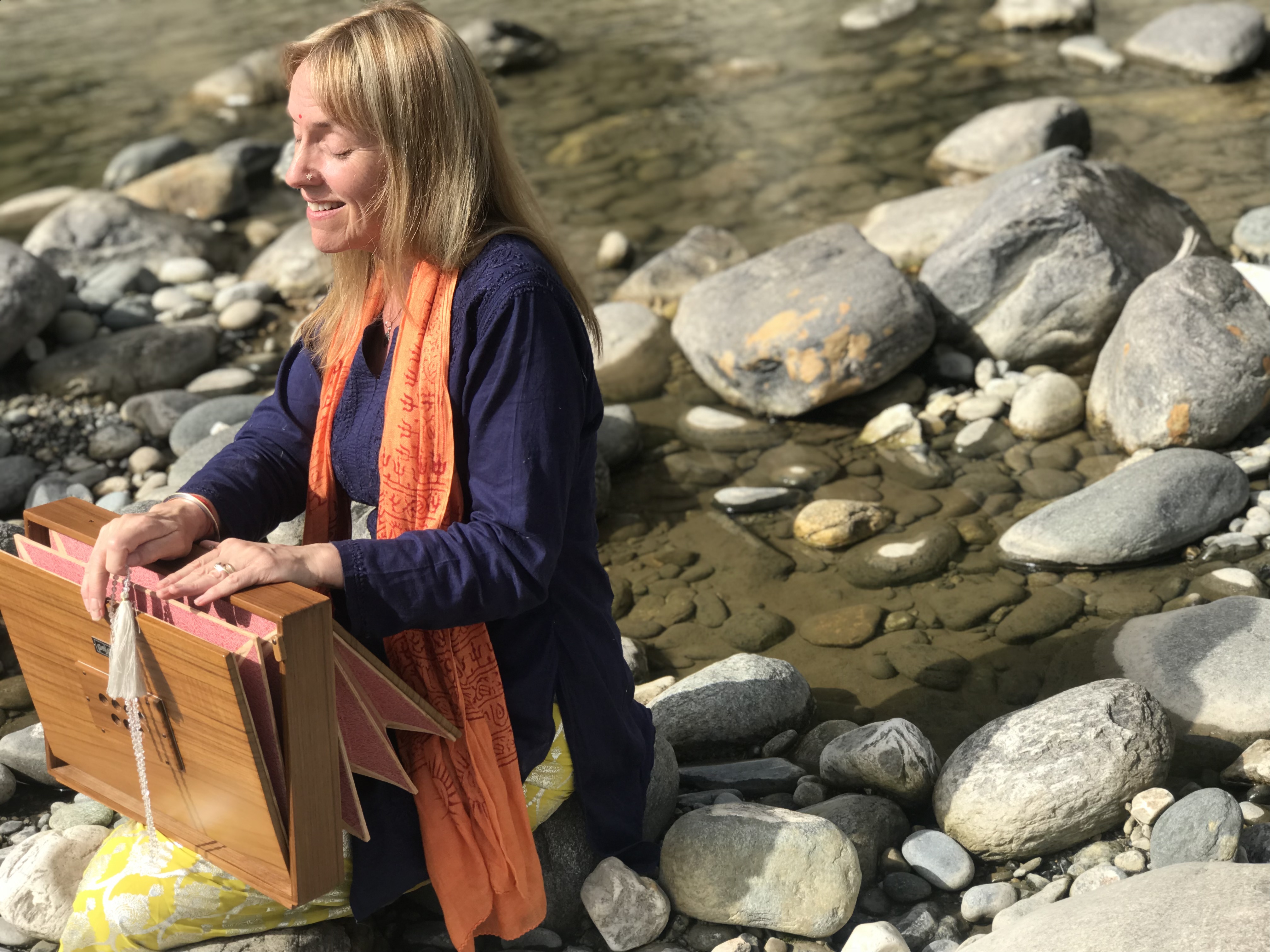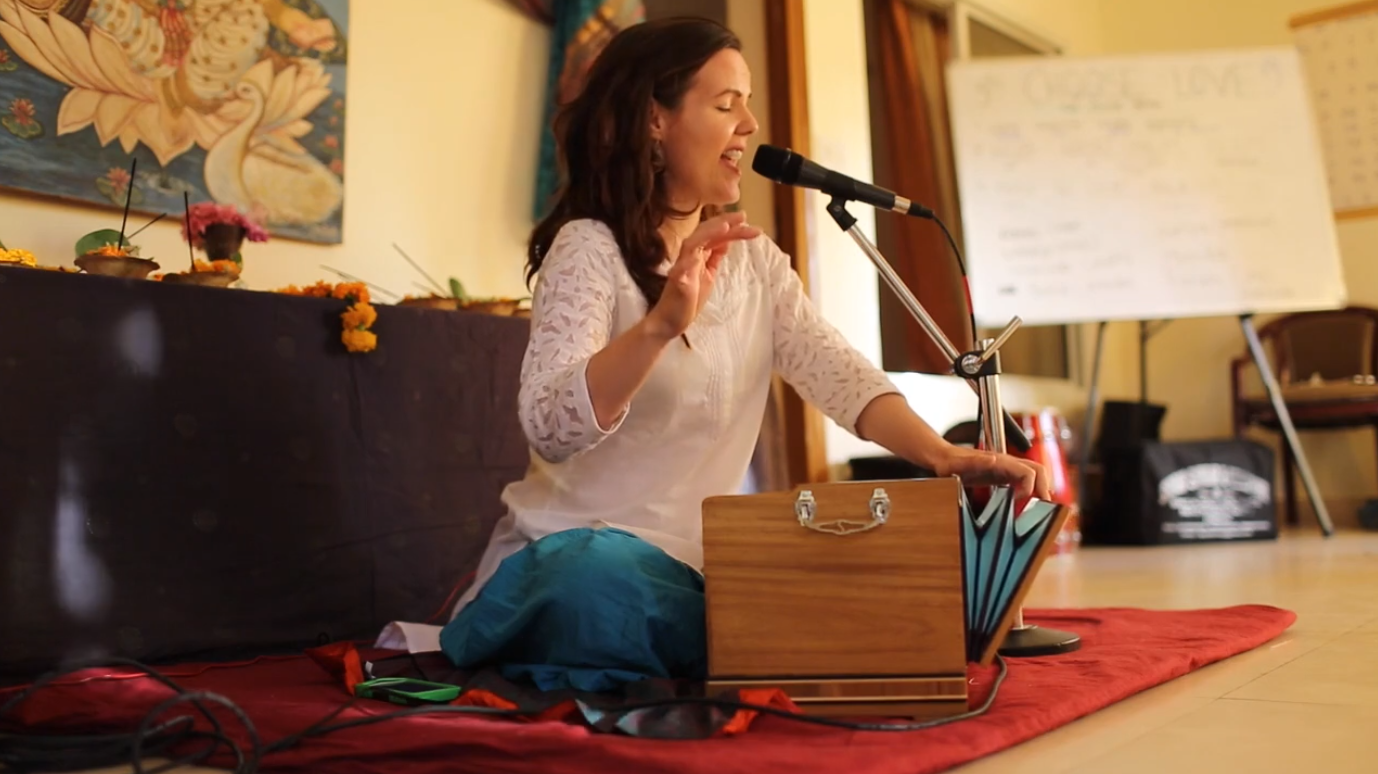Buying a Harmonium: Where, How, and What to Look Out For!

Almost no two harmoniums are alike! Your harmonium might become your new best friend for your chanting practice, and is an essential if you want dive deep into nada yoga training to learn to lead Sanskrit mantra chanting or kirtan, but they can also be tricky to buy. I'll show you pictures of all of the different types of harmoniums, and give you experienced, professional harmonium buying advice!
First of all... Do I really need a harmonium? Why would I want a harmonium?
Over the past 15 years of teaching sound healing yoga in India and online, I offer a lot of options for students who don't want to invest in a harmonium, or who are intimidated by learning an instrument. (Including iPhone/Android apps, which are great in a pinch!)
However, whether you're a beginning nada yoga or Sanskrit mantra student, or an intermediate musician, having a harmonium to help you match your voice to the precise pitches and musical patterns you're learning is pretty darn important. Almost everyone who studies nada yoga or Sanskrit mantra chanting, or wants to learn to lead kirtan chants has one. Especially if you're taking a teacher training and want to incorporate Sanskrit mantra or nada yoga into your sound healing or yoga classes, you'll want a harmonium, because:
- It provides a lovely background sound to your voice
- It gives a nice, deep, rich, loud sound for your kirtan participants or sound healing clients to relax and sing into themselves
- It's your "response vocalist" if you're leading call and response
- You can play the instrument instead of singing whenever you need vocal rest
(Here's our dear friend and 200hr Nada & Mantra TT alumni, sound healing trainer Joseph Schmidlin, playing a smaller travel sized Paloma brand harmonium.)
Here are a few things to keep in mind when looking to buy a harmonium!
Method of Purchase: Should I buy a Harmonium Online or In Person?
- It's always best to play the instrument first to be sure you enjoy it's "voice." Without getting into too much technical detail, let's just say there are many different construction factors that can change the harmonium's sound. Especially if you're using it for sound healing you need to LOVE the sound! Look and ask around in your local area to see if someone has a harmonium for sale. Hindu temples and yoga studios are great places to start asking!
- If you can't physically play it yourself, perhaps your seller can play a few different ones for you over a virtual "test drive."
- If you're flying blind and buying one online, don't buy from just anyone. Harmoniums can be tricky instruments, and there is a huge range of quality out there. Chances are quite high that you'll end up with an instrument that's not ideal.
Keep reading below for features to consider, lists of places to be careful of when buying a harmonium, things to look/listen for when buying a harmonium, and a list of recommended online harmonium sellers!
Places and people to be careful of when buying a harmonium:
- Directly from the Indian manufacturer (Quality coming out of the same workshop varies widely, even from the best and most reputable sellers like Paloma/Haribhau, Delhi Musical Store, Bina, etc.)
- Off ebay or some random person on Craigslist, FB Marketplace, or other online harmonium store. Unless they'll take time to play it for you in real time online (via Zoom or Facetime, for example) and answer your questions, you don't know what you're getting.
- Buying direct from someone who is not a musician and doesn't play it.
- Buying direct from someone who has had an old instrument sitting in their attic for a decade. Chances are, it'll need some professional tuning and repair before it sounds lovely.
(Here's dear Elena in Germany at our Online Klang und Mantralehrer-Ausbildung auf Deutsch playing a dulcetina style harmonium. Notice the bellows on both the front and the back, and how narrow it is?)
Tuning an older or antique harmonium:
Usually harmonium tuners are hard to find, and it takes several hours to do it right. So the cost of re-tuning an old harmonium may be almost as much as buying a new one! It's worth it if the harmonium has sentimental value or is a really high quality older one.
If you go to all that expense and effort to revive an antique harmonium, you're probably serious about exploring the mystical depths of sound and mantra. You'll want to take your Sanskrit mantra and nada yoga practice to new depths! We have some fabulous courses for you. Our 200 and 500 hour Sound Healing Yoga Teacher Trainings, focus on Nada Yoga & Mantra and offer unlimited 1-on-1 support. We can also match you up with one of my musical guru brothers or sisters from the Indian classical music Indore Gharana, for private vocal lessons. Heaven!
(Here are Puala'a and Katerina, both graduates of our Sanskrit mantra and nada yoga training, playing a full concert sized harmonium at a sound yoga retreat on Kaua'i Hawai'i.)
Some of the things to look out for are when buying new & used harmoniums:
- TUNING!
Is the harmonium tuned to A=440? If not, you might have difficulty playing with other fixed-pitch instruments in the future.
If you prefer a harmonium tuned to A=432 to vibe with solfeggio frequencies popular among sound healers, enjoy your own practice but expect to have some compatibility issues with other players. (In our sound healing nada yoga and mantra trainings in person & online, we use A=440 because they're much more common and versatile.)
Is each key tuned in the proper interval to the other keys? Are some keys quite sharp or flat? (Use a tuner, or ask a musician friend to check the tuning for you.)
Are at least your most often played notes/chords/drone keys in tune with each other? (A lot of harmoniums have at least a few keys that are "off," but if they're not keys you often play, it's not a dealbreaker.)
Is the instrument sharp or flat overall? (Very old instruments are often sharp, if they've been tuned many times.) - Sticky keys (keys that don't bounce back up after you play them)
- Clacking, noisy keys
- Rust
- Dust on the interior
(Get your seller to open it up for you to look "under the hood" - dust inside the instrument can cause annoying buzzing sounds and can accelerate rust. Use compressed air and/or a vacuum cleaner extension carefully to get the dust out.) - Do the knobs work?
- Do the bellows work? Not leaking air?
When you pump air through the instrument (while making a musical noise, of course!) are you able to build a satisfactory amount of pressure to sustain the sound evenly? This takes a bit of practice for any new player, and is a bit different on each harmonium you play, but a good harmonium has a good "sustain." You should not have to sweat from overpumping to get a steady sound.
HOT TIP:
Feel free to print out this list and keep it with you when you buy a harmonium or talk to a seller. It covers the most common troubleshooting issues for buying a harmonium!

(Here is life coach Jess Simson leading a mantra meditation for her practicum at our 200hr sound yoga teacher training in India, by the banks of the Ganges river, playing a collapsible type travel harmonium. See the metal buttons on the side? The bellows folds down over the keys, you press the buttons, and whammo! It's a harmonium briefcase ready for travel.)
What type of harmonium should I buy?
There are several different types and sizes of harmoniums:
- Full sized concert harmonium (3 octaves or more, often with larger keys and lots of bells and whistles like knobs for drones, multiple sets of reeds, and even scale changers!)
- Travel/collapsible harmonium (2 to 2/12 octaves, often with slightly smaller keys and fewer knobs)
- Dulcetina (2 to 2/12 octaves, with keys to play melody but usually no knobs or capacity to set a drone with the wires)
- Shruti Box (1 octave, with the ability to set a drone but no keys to play melody)
Here are some questions to guide you in finding the right harmonium for how you plan to use it:
- Will you be traveling with your harmonium by bus, train, or airplane? If so, you might want to get a smaller model or collapsible model built for travel, so it can fit in a wheelie suitcase and/or in the overhead bin of an airplane. If your long term goal is to teach Sanskrit mantra, incorporate nada yoga into your sound healing events, or lead kirtan for others, you'll be glad you bought a harmonium that you can travel easily with. (Trust me, because I toured internationally since 2009 teaching mantra trainings and leading sound healing certification courses, I travelled for years with a large harmonium that I packed inside a huge luggage piece, using my clothing for padding. It was a huge relief when I started using a smaller travel harmonium!)
- If you don't expect to need to cart it around much (i.e. if it's for leading nada yoga meditations or sound baths with mantra a studio space, or you'll be using it at home to support your personal nada yoga and mantra practice for your own meditation & self-growth), a full sized harmonium will offer the richest, fullest sound and is probably less expensive. A full sized harmonium can be moved easily by car, but not on public transportation without a heavy hassle.
- Do you need it mostly for the drone sound, mostly for melody only, or do you need to play the drone + a melody at the same time?
Drone only you can get away with an inexpensive Śruti box (no keys, only knobs for a sustained sound)
Melody only (or if you're an advanced one-handed player who can play chords and melody at the same time) you can look into a dulcetina or "Calcutta style" instrument that you can't set a drone manually on by moving the wires.
Drone + a melody at the same time you'll want the type that has wires "under the hood" so you can set 1-2 keys as a continuous drone, and play a melody as well. (Some harmoniums have knobs for drones, as well, but most only have 2-4 options and don't sound very good anyway.)
For the most versatile style of playing we teach at our sound healing nada yoga and mantra trainings, we recommend buying an instrument you can play a drone + a melody at the same time.
 (Here is sound healing trainer Sally Hutchinson leading a mantra meditation for her practicum at our 200hr sound healing mantra certification in India, by the banks of the Ganges river.)
(Here is sound healing trainer Sally Hutchinson leading a mantra meditation for her practicum at our 200hr sound healing mantra certification in India, by the banks of the Ganges river.)
Features to consider when buying a harmonium:
Range: Harmoniums come in several ranges, from 2 1/2 octaves and up; the average being around 3. Most players starting out should be able to work within 2 1/2 octaves.
Starting Note: Harmoniums may have their lowest note starting on any variety of notes. This is important to you if you're playing Indian classical music and your Sa-Pa drone is always set on F - Bflat; you might not want your drone stuck in the middle of your instrument. Play different harmoniums to see which sounds good to you, and/or ask your seller or music teacher to help you decide which configuration is best for you.
Reeds: Most harmoniums come with two reeds: a high (female) set and a low (male) set. They blend to create a rich, full sound. Some are automatically set to play both at all times. Many harmoniums will have knobs on the front that you can pull in and out to blend the reed mix according to your liking. It's nice to be able to play with the dynamics by adding in or fading out one of the reeds when you want.
Fancy Features: Additional bells and whistles may include stops, scale changers, and octave couplers. Stops and scale changers are not required unless you're playing songs with random new musicians a lot and need to change keys (without having to mentally transpose yourself on the keyboard).
An octave coupler can be a helpful feature. It adds an octave to the note you’re pressing down. It can add a level of dynamic increase at the right moment when you're leading a chant. It's absolutely not necessary though.
And now, the part you've all been waiting for...
Where we recommend to buy harmoniums online or in India!
In no particular order.
- If you're buying a harmonium in Australia, our sound healing nada yoga and mantra training students recommend Harmonium Australia
- If you're buying a harmonium in Germany, contact our dear alumni and co-teacher for Online Klang und Mantralehrer-Ausbildung Natalie Rausch for her recommendation: https://klangrausch.eu/ and mention ANANDRA for a discount!
- If you're registering for a Heart of Sound teacher training course in India, each year Anandra's Gurubhai Sudhanshu Sharma helps our students with a bulk order of harmoniums and tanpuras. He checks them all personally, too. Register for the Free Preparatory Course to get ready to come to India, and put your order in.
- Our friend and Heart of Sound graduate David Estes produces one of the best harmoniums! Several technological advances developed by him make it the most reliable, durable, practical instrument on the market. David personally checks each one he sells. http://www.ragamalapeti.com
- Also recommended for overall quality and customer service of harmoniums is Old Delhi Music in the US. They ship internationally, and the key factor is this:
The owner oversees the quality of construction, tweaks every harmonium after it is imported from India to make sure there aren’t any problems with it, packs it very well, and offers amazing customer service and troubleshooting. Contact the owner, Nic, or one of his staff to discuss your needs. Tell him Anandra sent you, just for fun! (We don't get any commission, this is an old-fashioned true recommendation.)
You can reach him at: 312-869-9092 or [email protected]

(And lastly, here's me! Leading a nāda yoga class at one of our most popular 200hr nada yoga and mantra trainings, and I'm playing a full concert sized harmonium.)
Happy harmonium shopping!
PS. If you found this level of detail helpful, just imagine our teacher training level online courses!
They include dozens of hours of harmonium how-to, harmonium 101 playing tips, harmonium care, and scores of videos of mantras & kīrtan for the harmonium. Check out our Sound Healing, Nada Yoga & Mantra courses!
We're certain that the value of the Heart of Sound courses greatly overdelivers compared any other harmonium kīrtan or bhajan online course available today. If you're also shopping around for online courses, feel free to contact us for more information!





